Python机器学习(三):梯度下降法
梯度下降法不是一种机器学习方法,而是一种基于搜索的最优化方法,它的作用的最小化一个损失函数。相应地,梯度上升可以用于最大化一个效用函数。本文主要讲解梯度下降。
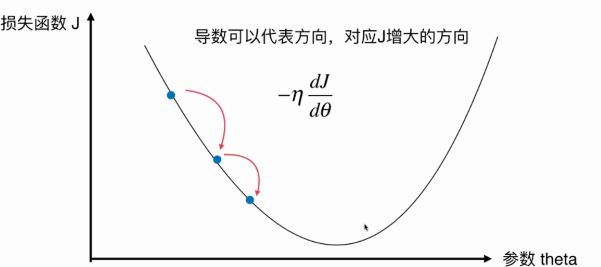
1.批量梯度下降
以线性回归为例子,梯度下降法就是不断更新Θ,每次更新的大小就是一个常数乘上梯度。其中这个常数η称为学习率(Learning Rate)。

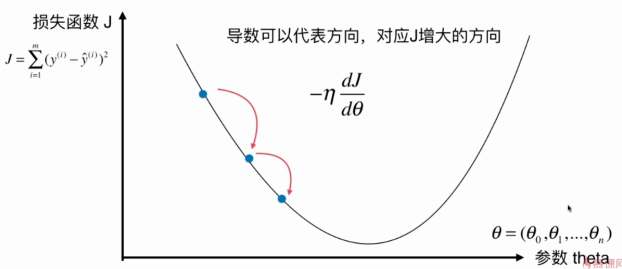

二元时可以把变化趋势图绘制出来。每一个箭头代表一次迭代。
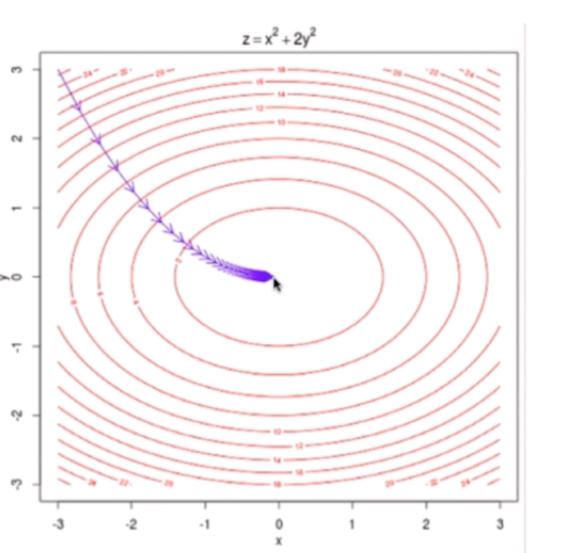
将梯度的每一项写成向量形式
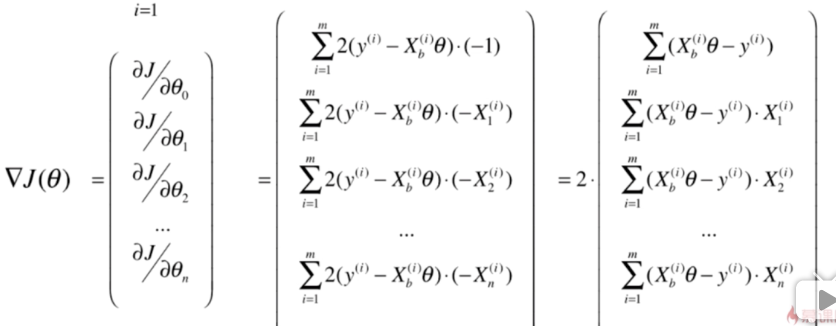
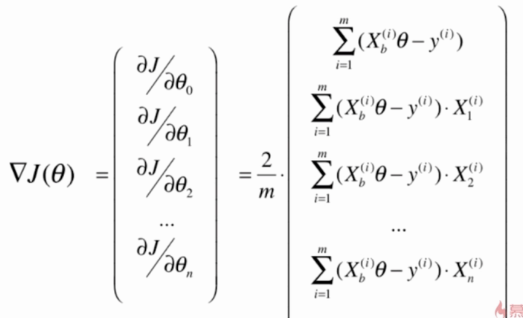
同样的,为了加快训练速度,可以将计算过程向量化
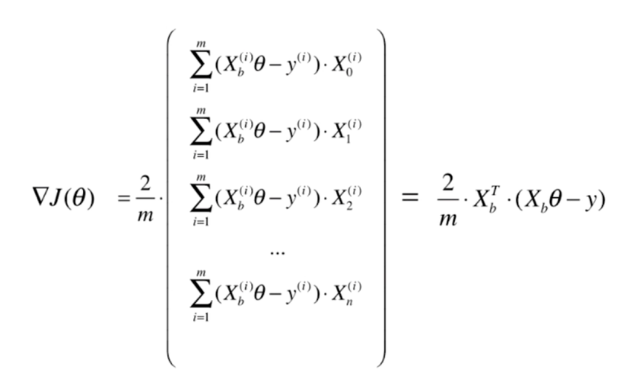
根据之前编写的LinearRegression类,可以用python封装成这种形式
"""
Created by 杨帮杰 on 9/29/18
Right to use this code in any way you want without
warranty, support or any guarantee of it working
E-mail: yangbangjie1998@qq.com
Association: SCAU 华南农业大学
"""
class LinearRegression:
def __init__(self):
"""初始化Linear Regression模型"""
self.coef_ = None
self.intercept_ = None
self._theta = None
def fit_normal(self, X_train, y_train):
"""根据训练数据集X_train, y_train训练Linear Regression模型"""
assert X_train.shape[0] == y_train.shape[0], \
"the size of X_train must be equal to the size of y_train"
X_b = np.hstack([np.ones((len(X_train), 1)), X_train])
self._theta = np.linalg.inv(X_b.T.dot(X_b)).dot(X_b.T).dot(y_train)
self.intercept_ = self._theta[0]
self.coef_ = self._theta[1:]
return self
def fit_gd(self, X_train, y_train, eta = 0.01, n_iters = 1e4):
"""根据训练数据集X_train, y_train,使用梯度下降法训练Linear Regression模型"""
assert X_train.shape[0] == y_train.shape[0], \
"the size of X_train must be equal to the size of y_train"
def J(theta, X_b, y):
try:
return np.sum((y - X_b.dot(theta)) ** 2) / len(y)
except:
return float('inf')
def dJ(theta, X_b, y):
# res = np.empty(len(theta))
# res[0] = np.sum(X_b.dot(theta) - y)
# for i in range(1, len(theta)):
# res[i] = (X_b.dot(theta) - y).dot(X_b[:, i])
# return res * 2 / len(X_b)
# 进行向量化
return X_b.T.dot(X_b.dot(theta) - y) * 2. / len(X_b)
def gradient_descent(X_b, y, inital_theta, eta, n_iters = 1e4, epsilon = 1e-8):
theta = inital_theta
cur_iter = 0
while cur_iter < n_iters:
gradient = dJ(theta, X_b, y)
last_theta = theta
theta = theta - eta*gradient
if(abs(J(theta, X_b, y) - J(last_theta, X_b, y)) < epsilon):
break
cur_iter += 1
return theta
X_b = np.hstack([np.ones((len(X_train), 1)), X_train])
initial_theta = zeros(X_b.shape[1])
self._theta = gradient_descent(X_b, y_train, initial_theta, eta, n_iters)
self.intercept_ = self._theta[0]
self.coef_ = self._theta[1:]
return self
def predict(self, X_predict):
"""给定待预测数据集X_predict, 返回表示X_predict的结果向量"""
assert self.interception_ is not None and self.coef_ is not None, \
"must fit before predict!"
assert X_predict.shape[1] == len(self.coef_), \
"the feature number of X_predict must be equal to X_train"
X_b = np.hstack([np.ones((len(X_predict), 1)), X_predict])
return X_b.dot(self._theta)
def __repr__(self):
return "LinearRegression()"
2.随机梯度下降
上面介绍的梯度下降是批量梯度下降(Batch Gradient Descent)。相对地,有另一种方法叫做随机梯度下降(Stochastic Gradient Descent),本质就是随机地选取一个样本点进行一次迭代,然后再随机地选取一个样本点继续迭代。这样做的优势就是——快!
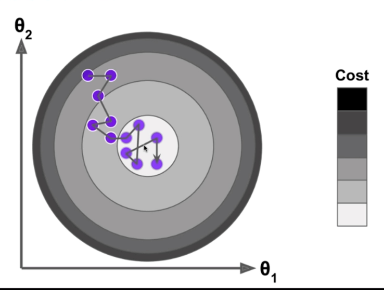
相对于批量梯度下降,随机梯度下降每一次迭代不一定会使损失变小。从统计的意义上讲,他会不断地向settle point附近逼近。实际情况中,往往在极小值附近会有比较大的抖动,而如果η选取过小,前面的迭代学习速度又会过慢。所以,我们在使用随机梯度下降的时候,会使用随着迭代次数而变化的learning rate,如下。

类似地,将下面的方法定义放到LinearRegression类中即可
def fit_sgd(self, X_train, y_train, n_iters = 1e4, t0 = 5, t1 = 50):
"""根据训练数据集X_train, y_train, 使用随机梯度下降法训练Linear Regression模型"""
assert X_train.shape[0] == y_train.shape[0], \
"the size of X_train must be equal to the size of y_train"
def dJ_sgd(theta, X_b_i, y_i):
return X_b_i * (X_b_i.dot(theta) - y_i) * 2
def sgd(X_b, y, inital_theta, n_iters, t0 = 5,t1 = 50):
def learning_rate(t):
return t0 / (t + t1)
theta = inital_theta
m = len(X_b)
for cur_iter in range(n_iters):
indexes = np.random.permutation(m)
X_b_new = X_b[indexes]
y_new = y[indexes]
for i in range(m):
gradient = dJ_sgd(theta, X_b_new[i], y_new[i])
theta = theta - learning_rate(cur_iter * m + i) * gradient
return theta
X_b = np.hstack([np.ones((len(X_train), 1)), X_train])
initial_theta = zeros(X_b.shape[1])
self._theta = sgd(X_b, y_train, initial_theta, n_iters, t0, t1)
self.intercept_ = self._theta[0]
self.coef_ = self._theta[1:]
return self
sciki-learn中可以这样调用SGDRegression
"""
Created by 杨帮杰 on 10/3/18
Right to use this code in any way you want without
warranty, support or any guarantee of it working
E-mail: yangbangjie1998@qq.com
Association: SCAU 华南农业大学
"""
from sklearn import datasets
from sklearn.model_selection import train_test_split
from sklearn.linear_model import SGDRegressor
from sklearn.preprocessing import StandardScaler
# 加载波士顿房价的数据集
boston = datasets.load_boston()
# 清除一些不合理的数据
X = boston.data
y = boston.target
X = X[y < 50.0]
y = y[y < 50.0]
# 分离出测试集
X_train, X_test, y_train, y_test = train_test_split(X, y)
# 数据归一化
standardScaler = StandardScaler()
standardScaler.fit(X_train)
X_train_standard = standardScaler.transform(X_train)
X_test_standard = standardScaler.transform(X_test)
# 训练模型
sgd_reg = SGDRegressor(max_iter=100)
sgd_reg.fit(X_train_standard, y_train)
# 打印结果
print(sgd_reg.coef_)
print(sgd_reg.intercept_)
print(sgd_reg.score(X_test_standard, y_test))
结果如下

3.总结
除了批量梯度下降法和随机梯度下降法之外,还有小批量梯度下降法(Mini-Batch gradient descent),方法是随机选取一小批样本进行迭代,原理差不多,这里不再赘述。
相对于使用正规方程解的方式解决线性回归问题,使用梯度下降可以在特征数量比较多的时候有更快的训练速度(比如图像识别)。有的机器学习算法只能使用梯度下降进行优化。
相对于批量梯度下降法,随机梯度下降法的特点:
- 能够跳出局部最优解
- 更快的运行速度
- 结果一般会稍差
损失函数不一定有唯一的极小值点(不一定是凸函数),这时候的解决方案有:
- 多次运行,随机化初始点
- 将初始点的位置作为一个超参数
References:
Python3 入门机器学习 经典算法与应用 —— liuyubobobo
机器学习实战 —— Peter Harrington
 关注公众号
关注公众号
低调大师中文资讯倾力打造互联网数据资讯、行业资源、电子商务、移动互联网、网络营销平台。
持续更新报道IT业界、互联网、市场资讯、驱动更新,是最及时权威的产业资讯及硬件资讯报道平台。
转载内容版权归作者及来源网站所有,本站原创内容转载请注明来源。
-
上一篇

Coding and Paper Letter(二十九)
资源整理,国庆套餐有点丰厚,分开两篇,老规矩,一篇Coding,一篇论文。 Coding: 1.R语言包dbplyr,用于数据库接口的dplyr。 dbplyr 2.世界的topojson数据集,包含有一些国家的数据。 topojson 3.LearnGitBranching是一个git存储库可视化工具,沙箱,以及一系列教程和挑战。 learnGitBranching 4.交互式的统计绘图,应当是基于Python的bokeh包。 my bokeh plots 5.书"Introducing Probability & Decision with a Visual Emphasis"的附录代码。 vip source 6.FSH556的课程材料:2018年春季在威斯康星大学课程:为生态学家设计的时空模型。 2018_FSH556 7.单变量或多变量数据的时空分析,例如,标准化多个物种或阶段的数据。 VAST 8.R包fastGHQuad,快速,数值稳定的Gauss-Hermite积分求取。 fastGHQuad 9.R语言包DatabaseConnector,使用JDBC连接数据...
-
下一篇

Springboot自定义异常处理
1.自定义异常类 import lombok.Data; @Data public class UserException extends RuntimeException { private Long id; public UserException(Long id) { super("user not exist"); this.id = id; } public UserException(String message, Long id) { super(message); this.id = id; } } 自定义异常类 2.编写异常处理handler import java.util.HashMap; import java.util.Map; @ControllerAdvice public class ControllerExceptionHandler { @ExceptionHandler(UserException.class) @ResponseBody @ResponseStatus(HttpStatus.INTERNAL_SERVER_ERROR) publi...
相关文章
文章评论
共有0条评论来说两句吧...
文章二维码
点击排行
推荐阅读
最新文章
- Docker安装Oracle12C,快速搭建Oracle学习环境
- CentOS关闭SELinux安全模块
- SpringBoot2整合MyBatis,连接MySql数据库做增删改查操作
- CentOS8编译安装MySQL8.0.19
- Docker快速安装Oracle11G,搭建oracle11g学习环境
- SpringBoot2编写第一个Controller,响应你的http请求并返回结果
- Docker使用Oracle官方镜像安装(12C,18C,19C)
- SpringBoot2配置默认Tomcat设置,开启更多高级功能
- Docker容器配置,解决镜像无法拉取问题
- MySQL数据库在高并发下的优化方案





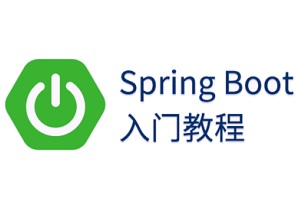
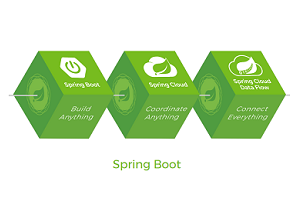


 微信收款码
微信收款码 支付宝收款码
支付宝收款码